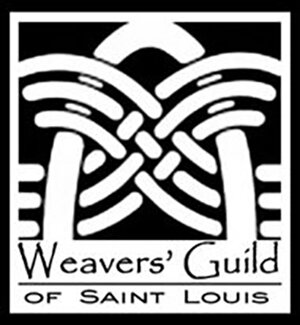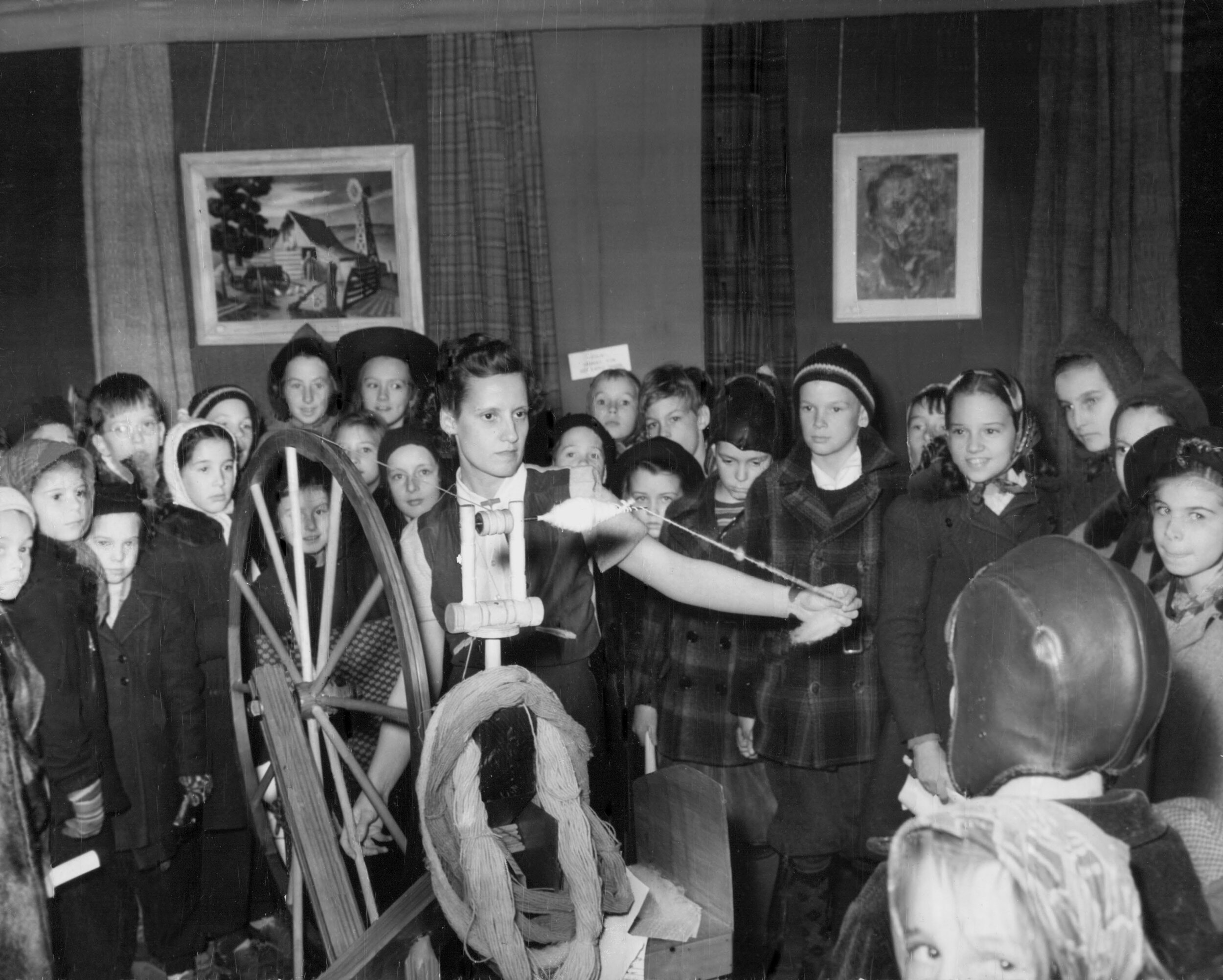
WGSL History
The Beginning - March 13, 1926
• The first recorded meeting of the Weavers (no apostrophe) Guild of St. Louis
• Presiding president, Katherine Rowse had already been elected. An earlier meeting must have taken place, but with no secretary to record it, we don’t know exactly when that was.
• Secretary-treasurer, Lucille Wiley was elected
• Guild name was chosen
The charter members were former students of Lillian Glaser* at the Art School of Washington University:
• Mrs. Minnie Clay Wuerpel
• Mrs. Jessie Harris
• Mrs. Rowse
• Miss Wiley
• Miss Ella Jurgens
* Glaser was probably away on sabbatical at the time of the founding of the Guild. Her name does not come up in the minutes until October 1926 when she was named to replace Miss Wiley as secretary-treasurer.
In order to join the guild a weaver had to live in St. Louis or vicinity, “present, each year, one finished piece, done by herself,” and conform to the rules of the Guild.
The by-laws were revised in October of that year, however, to allow for two levels of membership, producing and supporting. By that meeting there were apparently nine members, as the money on hand was $8.70 and the dues were one dollar per year. (Some had been spent on post cards.)
The Guild’s Roots at Washington University
Edmund Wuerpel, dean of the School of Fine Arts at Washington University, thought that weaving had a place beside painting and sculpture in fine arts.
Lillian Glaser, who learned to weave as a student at the School and then went on to become the weaving teacher in 1919, inspired her students so much that several of them continued, with the blessing of Dean Wuerpel, to gather at the weaving room even after they were no longer enrolled in the class. The dean’s wife was one of them. And finally, another former student, Mrs. Jessie Harris, became aware of the Weavers’ Guild of Boston through her visits to that city. These women then set about to become the second weavers’ guild in the U.S.
Glaser encouraged an academic and artistic approach to weaving that was very different from the Colonial Revival branch of weaving being promoted by Mary Meigs Atwater at the time. The members, who numbered about thirty-five by 1930 when they received their first national acclaim through an exhibit at the Boston Society of Arts and Crafts, were inspired to strive for excellence whether weaving handbags, linens, or exquisite tapestries fit for a museum.
Tragically, Lillian Glaser fell asleep while working on a dyeing project and a pot boiled over which extinguished a gas flame. She was asphyxiated at the age of 43. It will never be known whether the Guild could have survived the death of Miss Glaser in 1931 had it not been for the Wuerpels’ perseverance in securing the appointment of Sara Mattsson to succeed her.
Sara Mattsson, though quite young, was a member of a famous Swedish weaving family and had received rigorous training in utilitarian crafts before becoming a prize-winning tapestry artist. Mattsson’s work was on display in Cleveland where she spent a summer with her sister who had already emigrated. Dean Wuerpel sent his wife to Sweden to convince Sara to come to St. Louis, then they had to convince the State Department that she would not be taking a job that a U.S. citizen could do.
Mattsson was only at Washington University for five years--she left to marry and move to Cleveland in 1936--but she taught many future Guild members (including our own Connie Hilgert) and returned often to visit friends or give workshops and programs.
By the time Mattsson left, the Guild was well-established. New leaders had joined the charter members. One of them, Grace Brumbaugh, had joined the Guild in 1927. She was a strong leader and maintained her membership in the Guild until her death in 1998. She served as president for four, and possibly five, years during the 1930s.
Weavers' Guild of St. Louis picnic at Norrington, the country estate of Jessie Harris (seated in chair). Sara Mattsson (seated on the ground in her Swedish national costume) circa 1930s.
How History Shaped the Guild
The Great Depression affected the finances of the Guild because of a bank crisis, with the balance in the treasury falling to as low as twenty cents at one point, though it had never been very large owing to dues being only one dollar per year. Meetings, speakers, and exchanges of exhibits continued as usual, however, with the addition of new topics related to the WPA weaving project and the need for weaving teachers for occupational therapy. Ironically, some of the early members’ best work was created during this bleak time in U.S. history.
World War II, however, required the Guild to scale back and refocus its energies. The number of meetings per year was cut because of gasoline and tire shortages, and fewer outside speakers were available. The biennial exhibits continued, though with fewer original items, until the scarcity of weaving materials finally made it impossible to maintain the standards demanded by the members. Charitable activities, such as the weaving of lap robes to send to military hospitals and the threading of looms for veterans’ therapy, allowed the Guild to contribute to the war effort. Elisabeth Tenney and Minnie Clay Wuerpel led these projects.
After the war it took a while for the Guild to recover. Interest in weaving and quality of work had waned and dissolution of the Guild was even considered, but the contributions of a few talented teachers and new leaders breathed life back into the group.
In 1949 membership was opened up to weavers from across the river in Illinois. Libbie Crawford came to St. Louis in 1952 and Helen Wenzel joined in 1953. Gradually the Guild embraced the exploration of new techniques and materials through mini-workshops led by members. Two small-loom projects were undertaken in the late 1950s in which different weavers wove samples on the same warps, showing the variety of effects that could be achieved. These were assembled into popular exhibits which traveled all over the country.
The 1960s and 1970s were a time of experimentation and activism in society, including an explosion of interest in arts and crafts. From this came more ways for Guild members to connect. Community service was stressed. Study Groups allowing members to focus on specific aspects of fiber, such as tapestry or garments, became an important part of the Guild experience. Opportunities for members to participate in regional and national organizations of fiber artists abounded. WGSL members were active in Craft Alliance and the Artists’ Guild in St. Louis, the Midwest Weavers’ Conference, the Missouri Fiber Artists’ Association, and the Handweavers’ Guild of America. As weavers started wearing their art, style shows and programs on fashion became more prevalent.
By the 50th anniversary of the Guild in 1976, membership neared 100, with an average attendance of 45 per meeting, big name speakers were being brought in, and Articles of Incorporation as a non-profit organization were filed.
By the 1980s weaving was popular enough to support national magazines and exhibits. WGSL instituted an evening group as well as the regular morning meetings. Members had opportunities to show their works in galleries offering fiber art and wearables. The interest in fashion continued but with increasing sophistication and/or artistic expression. A turning point in WGSL history was the first Guild Sale in 1983. An annual event, with commissions going into the Guild scholarship and enrichment fund, it is still a much-anticipated fall event for members and shoppers alike.
For many the availability of information through books, magazines, workshops, and later the internet, led weavers to explore other fiber techniques--spinning, dyeing, felting, basketry, bead and embroidery embellishment, knitting, paper making, and art quilting, to name a few. By the turn of the millennium, it was not unusual to see many techniques combined in one piece. 2001 was truly “A Fiber Odyssey” with the Guild sponsoring a major 75th anniversary exhibit, hosting the Midwest Weavers’ Conference and presenting the “Small Expressions” exhibit of the Handweavers’ Guild of America. The Guild has also entered the information age with digital records, a website, and a newsletter transmitted by email. Some members have advanced to complex weaving using computer-assisted looms and specialized software.
Since the founding, the Weavers’ Guild of St. Louis has lived up to its original purpose. Its members have continued to create products of high quality, whether works of art or functional pieces of excellent design and execution. The Guild has provided an atmosphere of intellectual, educational, and artistic stimulation. Its intent is to carry on this tradition for the benefit of future generations. This is the best way to honor those who created and preserved this institution and served our community so long and so well.
“After 67 years in the guild, I still find pleasure in weaving and the close friends who share this love.”
“50 years ago, after joining the guild, Libbie Crawford became my weaving teacher and best friend, giving me a lifetime advocacy.”


















